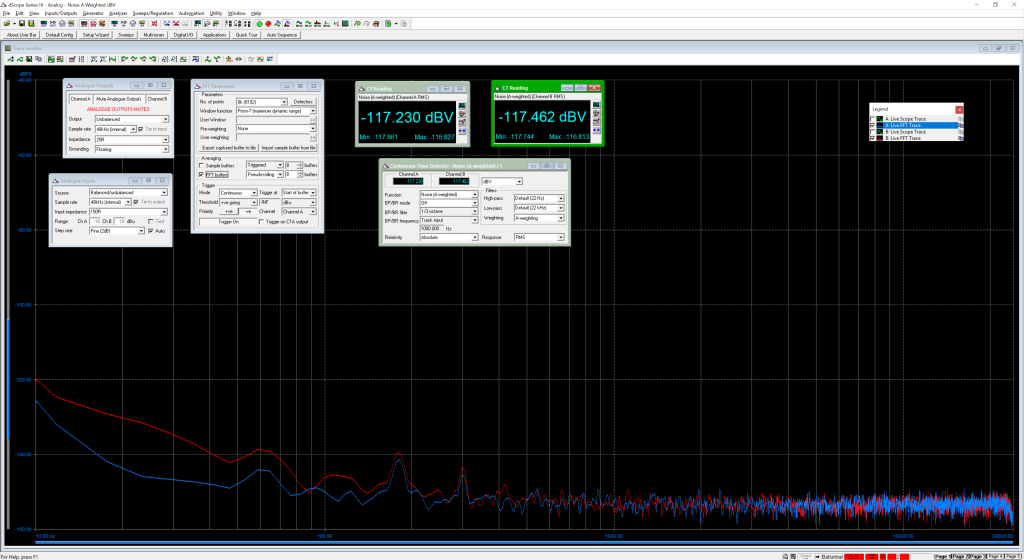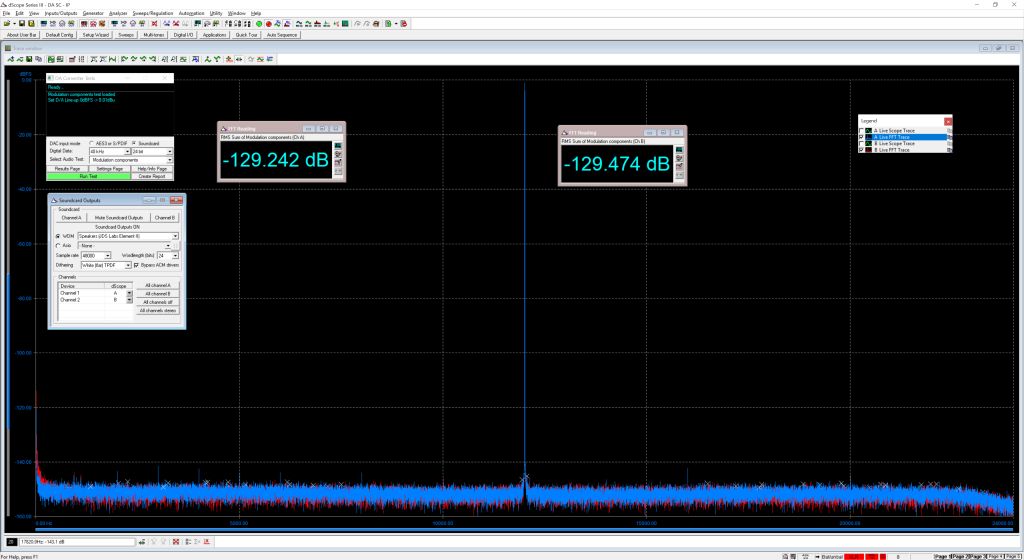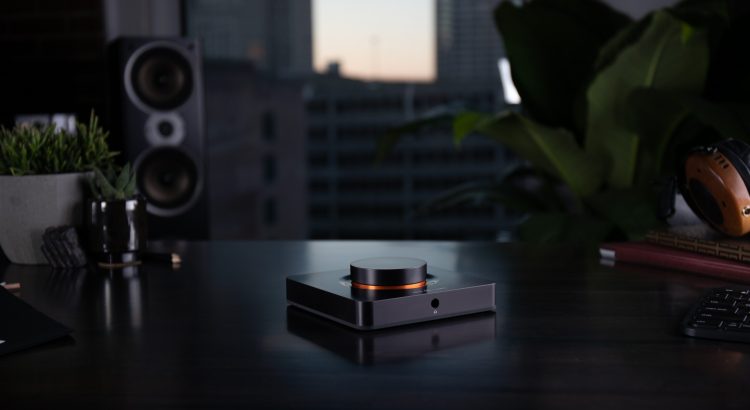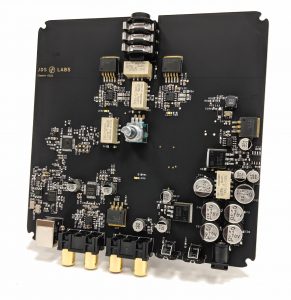JDS Labs Element II
The Element is a timeless mechanical design which has remained in demand for over four years with only minor electronics improvements. While we could keep building the same, we’re excited to share more of our best work.
Element II has been re-engineered as the flagship JDS Labs amp+DAC and amplifier. If you’ve been looking for a metal version of Atom Amp, Element II adopts the core amplifier technology in a CNC milled, aluminum chassis. Preamp RCA outputs are button controlled, so you can use the large knob to adjust your speakers without disconnecting cables.
Of matching caliber, Element II destroys digital-to-analog performance of the previous generation. An XMOS USB controller and MEMS oscillator improve jitter by two orders of magnitude, and the AK4493EQ DAC pushes dynamic range and THD+N to impressive levels.
Hardware Overview
Amplification and Power Stages
Element II is DC coupled throughout, relying on +/-15VDC rails derived from internal AC rectification with 50% more input capacitance and lower ripple compared to the first generation. The amplifier and USB DAC are both powered by an external 16VAC 1000mA transformer. Element II runs safely warmer than Element, as expected from powering its own DAC (no more USB power).
Amplification circuitry and PCB layout are inspired by Atom Amp, with greater PCB surface area dedicated to amplifier thermal relief. Higher noise tolerance NJR opamps are utilized in the voltage gain stage, along with thin film resistors for tighter channel matching. In short, this means less variation from one assembly to another.
The amplifier accepts up to 2.2VRMS at high gain of 4.73x, with headroom for Element II’s 2.0VRMS DAC. Low gain is set to unity (1.0x) for sensitive headphones. Volume is controlled by an Alps 9mm potentiometer with optimal 15A taper.
Relays
Instead of mechanical switches, a microprocessor controls hardware muting, gain, and preamp output events.
Integrated Preamp
The Mode button allows you to easily toggle between headphones and RCA preamp output. Firmware forces Low Gain when entering preamp RCA output mode, and remembers your gain setting when returning to headphone mode.
DAC
Element II relies on an AK4493EQ for digital-to-analog conversion. We debated sticking with the popular AK4490EQ, but favored the small increase in dynamic range.
USB Input
Element II is the first JDS Labs DAC to utilize an XMOS XU208 based USB Audio Class 2 implementation, supporting up to 32/384kHz PCM.
The XU208 is clocked by an SiTime MEMS oscillator with phenomenally low jitter, outperforming the original Element by two-orders of magnitude. Jaw dropping. Can I hear it? Afraid not. But it remains technically impressive and we did not have to re-invent the wheel. I only regret not moving to XMOS sooner.
Element II ships with a custom 1m (3.2ft) USB cable equipped with a ferrite core for best EMC and noise performance. We have been using TDK ferrites to conduct in-house measurements for years, and find that jitter measurements are more repeatable from one system to another when doing so.
Firmware and Drivers
Element II uses all new firmware for both its microcontroller and USB stage. We enabled and verified DFU operation in the XMOS codebase, meaning Element II supports future USB controller updates.
No drivers are required by Windows 10 or modern version of Mac OS or Linux. You may optionally install Element II’s XMOS driver for ASIO support. For now, Element II will rely on royalty-free XMOS drivers. If there is sufficient demand, additional features will be considered in the future.
Current versions of Android and iOS have also been tested successfully. Please note that UAC2 support varies with mobile devices (see FAQ).
Benchmarks
All tests are conducted with Elements II’s supplied 16VAC 1A transformer and ferrite equipped USB cable, using XMOS release driver v4.13.0 under Windows 10, using a dScope Series III analyzer.
Power measurements are observed with a 32.4 ohm load at 100Hz and 1000 Hz for at least three minutes continuously, while maintaining < 0.0025% THD+N.
Amplifier Performance
| Element | Element II | |
| Frequency Response 10Hz-20kHz (192k) | +/- 0.1dB | +/- 0.02dB |
| THD+N 1Khz, 150 ohm | 0.0009% | 0.0008% |
| THD+N 20Hz-20kHz | < 0.003% | < 0.001% |
| IMD CCIF 19/20 kHz -6.03 dBFS | 0.0004% | 0.0001% |
| IMD SMPTE -6.03 dBFS | 0.0005% | 0.0005% |
| Noise (A-Weighted) | -108 dBu | -115 dBu |
| Crosstalk -10 dBFS 100K RCA | -67 dB | -88 dB |
| Output Impedance | 0.1 ohm | 0.1 ohm |
| Channel Balance | +/- 0.56 dB | +/- 0.56 dB |
| Max Continuous Output, 600 ohm | 140 mW (9.4VRMS) | 165 mW (9.9VRMS) |
| Max Continuous Output, 150 ohm | 505 mW | 656 mW |
| Max Continuous Output, 32 ohm | 1.1 W | 1.3 W |

DAC Performance
| Element | Element II | |
| Frequency Response 10Hz-20kHz (192k) | +/- 0.15dB | +/- 0.13dB |
| THD+N 20Hz-20kHz | < 0.003% | < 0.001% |
| IMD CCIF 19/20 kHz -6.03 dBFS | 0.00110% | 0.00041% |
| IMD SMPTE -6.03 dBFS | 0.00120% | 0.00029% |
| Noise (A-Weighted) | -102 dBu | -109 dBu |
| Dynamic Range (A-Weighted) | 112 dB | 118 dB |
| Linearity Error -90 dBFS | -0.02 dB | 0.00 dB |
| Crosstalk -10 dBFS 100K RCA | -100 dB | -107 dB |
| USB Jitter Components 12kHz | -106 dB | -127 dB |
| Features | ||
| Maximum DAC Line-Output, 100K | 2.1 VRMS | 2.0 VRMS |
| RCA Output | Line-Out (fixed) | Preamp-Out (adjustable) |
| Relay Muting | Yes | Yes |
| USB Controller | SA9023A | XMOS XU208 |
| D/A Converter | PCM5102A | AK4493EQ |

Prototyping Banter
Element II has been in the works for years and we’ve accumulated a box full of canned prototypes.
In fact, Atom Amp was derived from Element experiments. We’d tentatively planned Element II for a 2018 release, but I was frustrated by unimpressive performance gains, or worse, diminished performance, of early prototypes. At one point, analog input was accomplished through a costly ADC. I took a step back and checked our goals: (1) Enable preamp output, (2) Modernize the amp+DAC , and (3) Don’t fix what’s not broken. Focusing only on the top goal was the trick, and this led to a tangent we dubbed Atom Amp. The lessons learned from building Atom Amp were merged back into Element II.
Alas, Element II missed its first release in early 2019 due to EMC compliance failure. We had embarked on an idea that required a USB daughter-card, in order to simplify inventory and production batches. I knew it would be a risk for I2S to jump a ground plane. This choice was the first time we failed FCC and CE emissions checks. We returned to a single board and invested in a 1.5GHz spectrum analyzer to rapidly reach compliance. Thus, Element II debuts at version 2.11. 🙂
Reviews
- More coming soon!
Availability
Element II is in stock and ships today!


> Element II missed its first release in early 2019 due to EMC compliance failure. We had embarked on an idea that required a USB daughter-card, in order to simplify inventory and production batches. I knew it would be a risk for I2S to jump a ground plane. This choice was the first time we failed FCC and CE emissions checks. We returned to a single board and invested in a 1.5GHz spectrum analyzer to rapidly reach compliance. Thus, Element II debuts at version 2.11. ?
That’s really impressive. Congratulations on the launch, guys!
In fact, you hinted at end of year release. YOU ACTUALLY DID IT~~~~
Thank you!
Are there any performance-related pros and/or cons to the Element II versus the EL stack or is it literally just the same hardware in a single box?
Element II is an EL Amp with the USB stage and DAC from EL DAC II. There are no performance differences that I have observed.
Element II is your best choice, unless you need the additional inputs of EL DAC II.
Well, I ordered mine. I have been looking for a transparent DAC with an amp as good as the Atom for a while. This sounds like it fits the bill perfectly.
Darn you! Your amplifiers and DACs are so unbelievably good and now that I just had settled in and was getting comfortable with my Atom and Khadas Tone Board stack, this aural delight comes along…
I own the Element which is already very good. Do I need to upgrade to Element II to gain any audible improvement (especially now Element II is DC coupled, can I expect any audible improvement)?
I guess the coupling caps are used to block bias current going into the pot like in the O2? Will removing the caps result in some noises when turning the pot in the long run? May I know the reason for removing the coupling caps?
@Jimmy – Yes, the original Element is already a competent amplifier. Element II measures even better, but should not yield dramatic changes to sound quality.
DC coupling was chosen for Atom Amp last year for its higher performance, and we made the same decision for Element II and EL Amp II. Of the thousands of Atom Amps in the wild, we have no concerns. Keep in mind that wiper noise can also occur with AC coupling. Switching to DC coupling does not stop this effect. It only eliminates source DC offset, which is increasingly rare. By using DC coupling, a few customers have quickly realized when their sources fail with high offset–the result is much different when using a DC coupled amp.
John, thank you for your explanation. May I ask a few follow up questions to have your expert answers?
– What is the reason for the wiper noise, if it is not due to bias current going into the pot?
– What kind of sources could have high DC offset which as a user should avoid?
– Can I safely use some jumper wires to short the coupling caps in my Element and my O2 to have some performance gain?
Wiper noise occurs by nature of rubbing against a surface, much like brake pads on a car. It’s usually a quiet process, but there is no guarantee. Again, adding DC bias pronounces the effect whether the amplifier is AC- or DC-coupled.
To my knowledge, the only actively produced audio sources on the market with DC offset are those which have failed. Consumer audio devices should not present DC offset.
Yes, you are welcome to jump the AC capacitors on your Element and O2.
The video review at the bottom of the page makes me think that this amp has too much power for IEMs, like the Shure range etc., even with the low output setting. I feel like I’d want to pipe the audio through ~30dB pads so that the potentiometer could be somewhere above nearly off. Seems safer too. Am I overly concerned for no reason, or misinterpreting?
@Patrick With thousands of Elements produced over the years, we have no such feedback from those using IEMs. There should be no difficulty using low gain of 1.0x with the gradual 15A taper. Element II has greater dynamic range and lower noise floor than the first generation, so IEMs should pair better than ever.
If you still need more volume range with an ultra efficient IEM, you can reduce the DAC volume level as needed. I have no concerns with IEMs.
John, first of all congratulations on another awesome DAC/amp!
It’s like you guys heard my thoughts, I was quietly wishing an Element with preamp outs and ability to switch between headphones and speakers existed! I purchased the original Element some time ago, but didn’t keep it because of the lack of preouts, otherwise a fantastic DAC/amp, enjoyed it greatly used with my headphones.
This is by a long, long way the best desktop solution for my needs and having owned and used it for a few days now, I am impressed with the sound quality, aesthetics and overall build quality!
The only thing I’m not enthusiastic about is the choice to hold the button to switch between outputs. I think it should have been the other way around, hold to turn on/off and then just press to switch output. To my mind it make more sense, since the only reason you reach for that button is to switch AFTER it’s on and there would be a smaller chance to turn it off by mistake.
Than again, while I wish that were the case, it’s something I can live with if it’s the compromise I have to make in order to get the pros I listed!
Thank you for the Element II!
Thanks, Emil. It should be a simple matter to reverse the short/long press logic. This change would need to be made at the time of order, however, as the button logic resides in system firmware, separate from the field upgradeable USB engine.
I was wondering if it were as simple as a firmware update and wish I had known that before I ordered it (bit over a week ago)… Any way an optional firmware update could be made available for anyone wanting to have the button short/long press reversed?
Reprogramming the button behavior must be performed at JDS Labs. Only the XMOS USB engine can be upgraded easily. Feel free to email if you would like to send in for modification.
Afternoon John,
I am looking to place an order for the Element II (man this is a beautiful unit), how would I go about requesting the update of having a long press on the power button be on/off and a short press for the audio output source change?
Thanks,
Nitan
@Nitan – Please mention your special request in the Shipping Notes field during checkout. Thank you!
Any benefits from buying an EL stack vs the element other than being able to swap out the dac or amp on the stack? Specs seem similar but the stack costs a lot more.
James
James – Your understanding is correct. You can also add an EQ in-between a separate amplifier and DAC, although few choose such an option. Element II is the best choice if you only plan to use USB input.
I know that it’s impossible for now, but perhaps in the future is it possible to have the metal not pick up so many finger prints?
Brushed aluminium, especially black does not agree with my fingers D:
Can this be used as a DAC only with a fixed output ? Or is the volume control always in play whe using the pre out ?
@Glenn: Yes, Element II’s preamp RCA outputs are always impacted by the volume knob position. To use as a ‘fixed output’, simply turn the knob to 100%. This gives flexibility if you ever need to reduce the DAC output level.
Alternatively, you may want to consider an EL DAC II if you only require fixed DAC output.
I’ve used Atom for a while now and found it quite satisfactory, but the Element seems to be worth a shot.
I bought my Element I in 2017. I have loved it everyday since — pretty much. It drives my various cans with ease and grace. Also, some time ago, you kindly sent me new rubber feet when one of mine got lost. If I’m absolutely honest, I can’t help but get a case of FOMO with this new Element II.
Anyway, I love my Element I and JDS Labs is an awesome company. Seriously, this black box is gorgeous and magic. Thank you.
Any preference for the black ring or copper ring? I want to order a Element II but I cant decide which color ring to get!
I just ordered my third JDS product. Black is a little too sterile looking (Pro?), red is nice but kinda says ‘gamer’. The copper (ordered) is very classy in my opinion.
I’ve been using my Element II for about a week now and I’m really impressed. It drives all my headphones well. In particular my DT990 600, a headphone that I was not overly impressed with but now enjoy with the Element II. In addition to providing the needed power for the 990 the Element II seems to tame the treble in the headphone and I’m able to listen for extended periods of time without fatigue.
One nice feature enhancement to the unit would be for the light ring to change color based on the sample rate of the music being played. It has nothing to do with the sound, but it would add a little more to an already great looking device. Maybe in the Element III
Thanks, Errol. I like the idea!